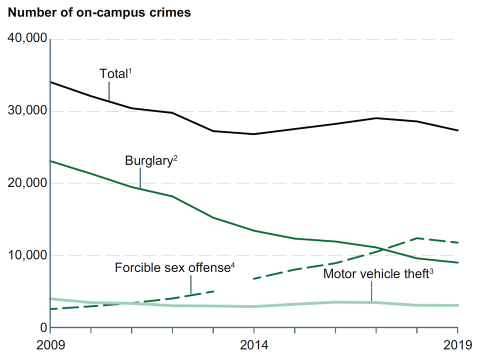Crimes committed on college and university campuses can have long-lasting emotional, psychological, and physical effects on victims, the entire student body, staff, and the surrounding community. These negative effects of campus victimization can include post-traumatic stress disorder, a fear of harm or violence, an inability to focus, and diminished academic performance.
September is National Campus Safety Awareness Month, a time to raise awareness about safety on college and university campuses nationwide.
Campus Safety Statistics
The Jeanne Clery Act requires colleges and universities to report campus crime data on criminal offenses, hate crimes, Violence Against Women Act offenses, and arrests or referrals for disciplinary action.
Between 2009 and 2019, the number of reported on-campus crimes occurring at postsecondary institutions decreased by 20%, according to the 2021 Report on Indicators of School Crime and Safety.
Of the 27,300 criminal incidents reported at postsecondary institutions in 2019, 43% were forcible sex offenses. Additionally, a total of 757 hate crimes were reported on campuses of postsecondary institutions, with more than half of these crimes being motivated by race or ethnicity. The most common types of hate crimes were intimidation, destruction, damage, vandalism, and simple assault.
For more data on campus crime, visit the Campus Safety and Security Data Analysis Cutting Tool from the U.S. Department of Education for rapid, customized reports.
Sexual Assault on College Campuses
Despite the downward trend in on-campus crime between 2009 and 2019, the number of forcible sex offenses increased from 2,500 to 11,800 during the same period, according to the 2021 Report on Indicators of School Crime and Safety.
Specifically, there was an 83% increase (an average increase of about 16% per year) in reported forcible sex offenses between 2014 and 2018, followed by a 5% decrease between 2018 and 2019.
A project supported by the Office on Violence Against Women presents a comprehensive campus model to address gender-based violence on college campuses by building broad campus and community engagement through coordinated collaboration and providing effective interventions and ongoing prevention and education programming.
Stalking Among College Students
Although legal definitions vary from one jurisdiction to another, stalking is generally defined as a pattern of behavior directed at a specific person that would cause a reasonable person to feel fear.
Research shows that 18- to 24-year-olds experience the highest rates of stalking among adults, making it vital for college campuses to address stalking victimization appropriately.
Between 6% and 39% of college students report being stalked since entering college. The majority of college student victims are stalked by someone they know and most stalkers are also students, according to the Stalking Prevention, Awareness, and Resource Center.
Those at a higher risk of experiencing stalking include women, students of color, LGBTQ+ students, students with disabilities, students living off campus, and younger students.
To support victims of stalking, campus programs are encouraged to listen closely to victims and refer them for additional support, provide appropriate accommodations to help them feel safe, and collaborate with external support services and the justice system to protect victims and hold stalkers accountable.
More on Campus Safety from OJP
Visit the following pages for additional information and resources produced or sponsored by the Office of Justice Programs and other federal agencies:
| Campus Safety: Crime and Safety | Campus Safety: Substance Use |



